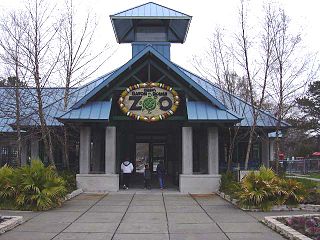
Brookfield Zoo, also known as the Chicago Zoological Park, is a zoo located in the Chicago suburb of Brookfield, Illinois. It houses around 450 species of animals in an area of 216 acres (87 ha). It opened on July 1, 1934, and quickly gained international recognition for using moats and ditches instead of cages to separate animals from visitors and from other animals. The zoo was also the first in America to exhibit giant pandas, one of which has been taxidermied and put on display in Chicago's Field Museum of Natural History. In 1960, Brookfield Zoo built the nation's first fully indoor dolphin exhibit, and in the 1980s, the zoo introduced Tropic World, the first fully indoor rainforest simulation and the then-largest indoor zoo exhibit in the world.

The Zoo Zürich is a zoo located in Zürich, Switzerland and together with the Basel Zoo is considered one of the best zoos in Europe. Opened in 1929, it is the third oldest zoo in Switzerland and it accumulated a collection of 2,200 specimens of 300 species by its seventy-fifth year. It is located on Zürichbergstrasse, on the lower reaches of the Zürichberg in the Fluntern quarter.

The Little Rock Zoo was founded in 1926 and is located in Little Rock, Arkansas, United States. It is home to more than 725 animals representing over 200 species, and covers an area of 33 acres (13 ha). The Arkansas Zoological Foundation is a private 501 c (3) organization that raises funds for zoo development. The Little Rock Zoo is a department of the city of Little Rock. It is the largest zoo in Arkansas, and the only Arkansas zoo accredited by the Association of Zoos and Aquariums (AZA).

The Birmingham Zoo is a zoological park that opened in 1955 in Birmingham, Alabama, United States.

The Sedgwick County Zoo is an AZA-accredited wildlife park and major attraction in Wichita, Kansas, United States. Founded in 1971, with the help of the Sedgwick County Zoological Society, the zoo has quickly become recognized both nationally and internationally for its support of conservation programs and successful breeding of rare and endangered species. Having over 3,000 animals of nearly 400 species, the zoo has slowly increased its visitors and now ranks as the number one outdoor tourist attraction in the state.

Gladys Porter Zoo is a zoological and botanical park located in Brownsville, Texas, United States. The zoo officially opened on September 3, 1971, and currently averages over 424,000 visitors annually. Situated on 31 acres (13 ha), the zoo houses about 400 animal species and over 250 tropical and neo-tropical species and subspecies. It is the first zoo to have successfully bred the endangered Jentink's duiker. It is also the birthplace of Harambe, the gorilla.

The Santa Fe College Teaching Zoo is a 10-acre (4.0 ha) zoo in Gainesville, Florida. Located on Santa Fe College's main campus, it is the only college zookeeper training facility in the United States. Since 2000, the zoo has been accredited by the Association of Zoos and Aquariums (AZA).

The St. Augustine Alligator Farm Zoological Park is one of Florida's oldest continuously running attractions, having opened on May 20, 1893. It has 24 species of crocodilians, and also a variety of other reptiles, mammals and birds, as well as exhibits, animal performances and educational demonstrations.

The San Antonio Zoo is an Association of Zoos and Aquariums-accredited zoo in Midtown San Antonio, Texas, United States. It is located in the city's Brackenridge Park. San Antonio Zoo is a 50+ acre zoo home to over 750 species, some of which are endangered or extinct in the wild, and an annual attendance of more than 1 million. It also runs non-animal attractions, such as the 2 ft narrow gauge San Antonio Zoo Eagle train ride, which first opened in 1956.

Shanghai Zoological Park, or commonly Shanghai Zoo in short, is the main zoological garden in Shanghai. It is located near the township of Hongqiao and is administratively in Changning District. Shanghai Zoo was formerly known as " Xijiao Park", which is still a common name used locally for the zoo.

Southwick's Zoo is a 300-acre (120 ha), privately owned and operated, zoological park located in Mendon, Massachusetts, United States. It was opened in 1963 and has been run by members of the Southwick and Brewer families ever since.

The Baton Rouge Zoo is located 15 minutes north of downtown Baton Rouge, Louisiana, United States. The zoo is owned and operated by the Recreation and Park Commission of East Baton Rouge Parish, Louisiana (BREC), and is home to over 800 animals from around the world. The zoo was first accredited by the Association of Zoos and Aquariums (AZA) in 1977 — the first zoo in Louisiana to be accredited. However, the zoo lost its accreditation in March 2018 due to infrastructure issues and animal escapes.

The Central Florida Zoo and Botanical Gardens is a 116-acre (47 ha) zoo and botanical garden located north of Orlando, Florida in Sanford. As a not-for-profit organization, it is a leader in conservation, providing experiences that inspire actions on behalf of wildlife. The Zoo has been an accredited member of the Association of Zoos and Aquariums (AZA) since 1986.

Banham Zoological Gardens is a 50-acre (20 ha) zoo in Banham, Norfolk, England. The zoo itself, which today is home to more than 2,000 animals, opened to the public in 1968, became a charity in 2013, and has since been often awarded the prize of Norfolk's Top Attraction, by numerous different organisations, with an annual visitor attendance of in excess of 200,000 people. It is part of the Zoological Society of East Anglia, a registered charity which also owns Africa Alive Zoological Reserve near Lowestoft, Suffolk.

BestZOO is a small zoo in Best, North Brabant, Netherlands. It opened in 1930 as Vleut the Zoo, and was owned and operated by the van Laarhoven family until purchased by Zodiac Zoos in 2007. Zodiac Zoos upgraded many of the old exhibits to more naturalistic settings, but sold them to Jos Nooren in 2010 before all upgrades were completed.

Barcelona Zoo is a zoo in the Parc de la Ciutadella in Barcelona, Catalonia, Spain. The zoo used to be internationally known as the home of Snowflake, the only known albino gorilla, who died in 2003.

Bramble Park Zoo is located in Watertown, South Dakota. Open since 1912, the zoo comprises 15 acres (6.1 ha) with approximately 500 animals representing 130 different species.
The Hemker Park & Zoo is a family owned zoo founded in 1977 in Freeport, Minnesota, United States. The zoo was founded by Mark and Joan Hemker.

Le Cornelle is a zoo and amusement park in Valbrembo, in the Lombardy province, northern Italy, created by Angelo Ferruccio Benedetti in 1981; extending over an area of 100,000 square metres.
The Zoo Taiping is a zoological park located at Bukit Larut, Taiping, Perak, Malaysia. Established in 1961, is the only zoo in northern Malaysia.


















